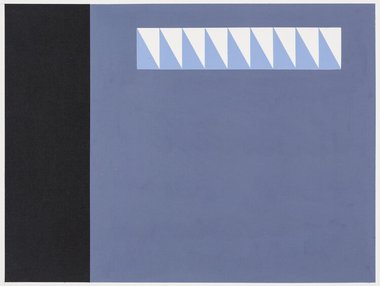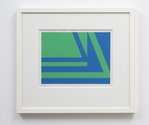John Hurrell – 23 February, 2020
What is fascinating is the wide range of Walters' enthusiasms, as indicated in his what-might-be-termed ‘improved appropriations'—the sheer variety of his formal interests, the expansiveness of his catholic taste—and the types of image created initially by others that excite him sufficiently that he wants to create his own version. It is as if he were in the studio with certain artists, starting a conversation, and curious about alternative compositional possibilities to their efforts.
Auckland
Gordon Walters
From the Archive
Curated by Laurence Simmons with Starkwhite
5 February - 29 February 2020
In this presentation from the Walters Estate, 36 works—3 acrylic on canvas paintings, 11 linear ink marker drawings, 3 collages and 19 gouaches on paper—are accompanied by a superbly informative essay by Laurence Simmons, dealing with Walters’ use of his own archive for almost five decades. One long wall has the drawings, and the opposite wall the gouaches and collages-with three canvases peppered around.
Even with the touring New Vision survey shown not too long ago, this display is full of surprises—such as there being no korus at all. It is an extension of Gordon Walters: Gouaches and a Painting from the 1950s (at Starkwhite in 2015)—also curated by Laurence Simmons. And in some ways Francis Pound’s fabulous little book En Abyme (2004).
Simmons’ beautifully illustrated elucidation for this show on PDF (and generously available from Starkwhite) is a real treasure. He was one of the three curators of New Vision—his writing and choices here provide a lucid focus. The many comparisons of Walters’ formally related studies (often spread decades apart) are immensely illuminating—testing out arguments for the artist’s rationale and his varied permutations around alignment, scale, tone, colour, transparency, extension, rhythm and reflexivity in an accessible manner. Even making you have a rethink about works you may already encountered many times in shows like New Vision, but here recontextualised and made ‘fresh’ again.
What is fascinating is the wide range of Walters’ enthusiasms, as indicated in his what-might-be-termed ‘improved appropriations’—the sheer variety of his formal interests, the expansiveness of his catholic taste—and the types of image created initially by others (ranging from Melanesian artists to John McLaughlin or Rolfe Hattaway) that excite him sufficiently that he wants to create his own version. It is as if he were in the studio with certain artists (linked to all sorts of varied visual cultures), starting a conversation, and curious about alternative compositional possibilities to their efforts; a bit cheeky and keen to suggest alterations; openly infatuated with specific intricacies of niggling detail that he might ‘fix’. Thereby making their work his own.
For the visitor there is great pleasure thinking about that detail, looking at thicknesses of shape, and placement or hue, and how Walters toys with width or height of linear elements, or spatial recession, or referencing of a page’s edge or rectangular shape—demanding that we look closely and try to analyse by comparing different sections.
His linear drawings are notations to himself and (out of context) quite private, but the coloured gouaches and collages are very communicative, being surprisingly intimate, as if he were whispering a softly gentle murmur suggesting you think about this edge, or that tone; and its spatial consequences.
Laurence Simmons will be talking about these works at Starkwhite on Thursday 27 February at 6.15 pm. Drinks and conversation at 5.30.
John Hurrell

![Grodon Walters, [Untitled], 1976, gouache. Image courtesy of the Walters Estate](/media/thumbs/uploads/2020_02/_75A0808web_jpg_380x125_q85.jpg)
![Gordon Walters, [Untitled], 1976, gouache. Image courtesy of the Walters Estate](/media/thumbs/uploads/2020_02/Il-479-2014GordonWaltersUntitled1976MB_29-03-20172_jpg_380x125_q85.jpg)


![Gordon Walters, [Untitled], collage. Image courtesy of the Walters Estate](/media/thumbs/uploads/2020_02/Il-458-2014GordonWaltersPreparatorystudy-UntitledgeometricpatternMB_29-03-2017_jpg_380x125_q85.jpg)

![Gordon Walters, [Untitled], 1976, gouache. Image courtesy of the Walters Estate](/media/thumbs/uploads/2020_02/Il-443-2014GordonWaltersPreparatorystudy-Untitledgeometricpattern1976_jpg_380x125_q85.jpg)

![Gordon Walters [Untitled], 1966, gouache. Image courtesy of the Walters Estate](/media/thumbs/uploads/2020_02/Il-328-2014GordonWaltersUntitledgeometricpattern1966MB_29-03-2017copy_jpg_380x125_q85.jpg)
![Gordon Walters, [Untitled], 1967, gouache. Image courtesy of the Walters Estate](/media/thumbs/uploads/2020_02/Il-314-2014GordonWaltersUntitledgeometricpattern1967MB_29-03-2017_jpg_380x125_q85.jpg)
![Gordon Walters, [Untitled], 1972, gouache, 365 x 270 mm. Image courtesy of the Walters Estate](/media/thumbs/uploads/2020_02/Il-171-2014GordonWaltersUntitled1972MB_31-03-2017copy2_jpg_380x125_q85.jpg)



 Two Rooms presents a program of residencies and projects
Two Rooms presents a program of residencies and projects Advertising in this column
Advertising in this column



This Discussion has 0 comments.
Comment
Participate
Register to Participate.
Sign in
Sign in to an existing account.